The Wildest, Rarest, and Ugliest Abandoned Russian Military Planes Revealed on Google Maps
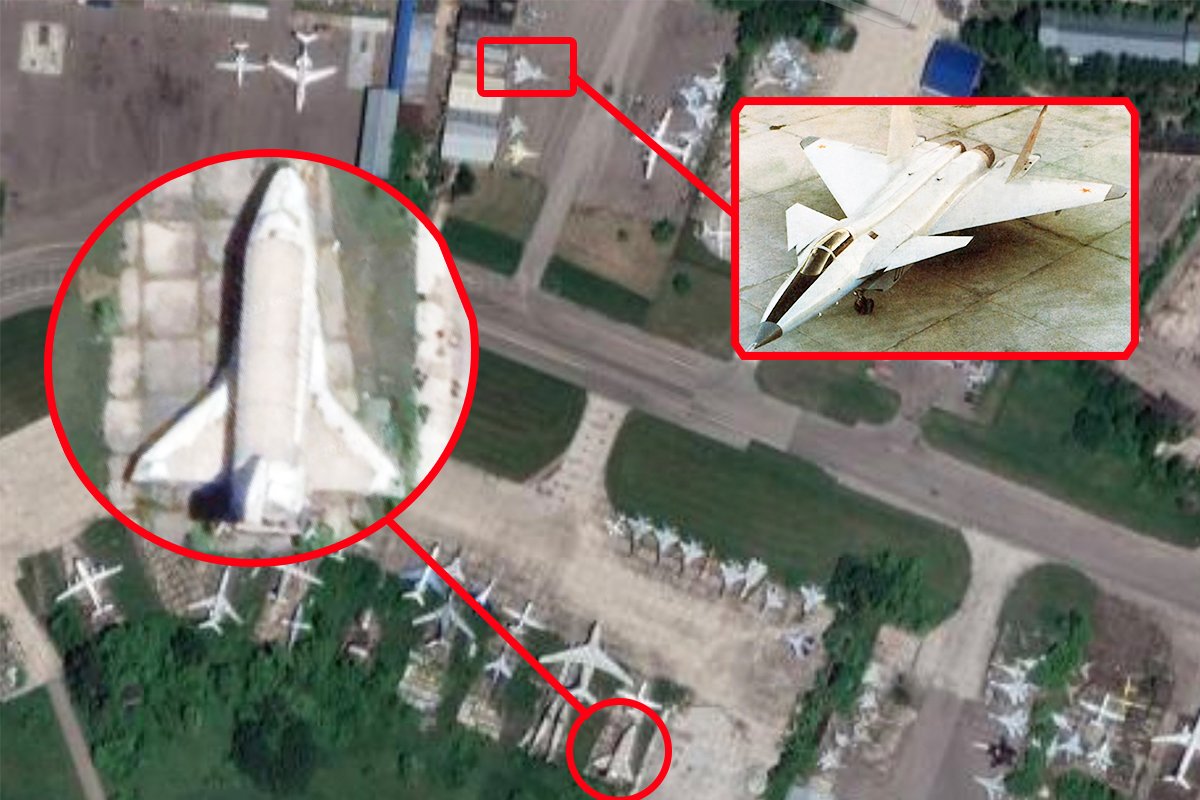
A treasure trove of rare, unique, and abandoned Russian airplanes — including a derelict Soviet space shuttle and a one-of-kind advanced MiG fighter jet — popped up among Google Maps watchers this week. Images courtesy of Google Maps, MAKS air show.
A false internet rumor sent a slew of online detectives searching this week for some of the rarest, most secret — and sometimes just ugliest — abandoned Russian military planes on Google Maps.
First, the false rumor: Early in the week, a story emerged that Google Maps, which provides satellite images of most of the world, had “stopped hiding” Russian military sites.
Google Maps has stopped hiding Russia’s secret military & strategic facilities. Allowing anyone in the public to view.
Open sourcing all secret Russian installations: including ICBMs, command posts and more with a resolution of 0.5m per pixel. pic.twitter.com/K77t0gmt3J
— OSINT UK (@jon96179496) April 18, 2022
The idea that Google “censors” military bases on Google Maps is not new. Imagery researchers have spotted many blurred-out areas with known military uses on Google Maps’ satellite image services, and the company did once hide French prisons after a gangster staged a breakout from a jail using images from the service. But many such sites were “hidden” because of the low-resolution images Google Maps often uses in areas that draw little attention from the general public, like rural US military bases and Afghanistan.
Today, most high-interest US sites, such as the home compounds of secretive special operations units and missile bases, are viewable on Google Maps in very high definition.
As for the rumors of a Russian reveal, many analysts and Google itself quickly said the company had made no changes to Russian coverage this week:
Hi there, please note that we haven’t made any blurring changes to our satellite imagery in Russia.
— Google Maps (@googlemaps) April 18, 2022
But other analysts still insisted that the quality of images on Russian sites had suddenly improved.
If this was unintentional (no policy shift or product changes) by Google Maps directly, then this may simply be the result of: increased demand on 3rd party satellite imagery providers for higher quality data for the region, along with any edits they make to the raw data
— OSINT UK (@jon96179496) April 18, 2022
Regardless of the timing or motive, just the news that Russian military sites might suddenly be clearer sent amateur imagery snoops rushing to check out Russian military hubs.
Several spotters zeroed in on an airport just outside of Moscow, Zhukovsky International Airport, which shares a runway and parking area with the Gromov Flight Research Institute, which is known by its Russian initials, LII. Both the airport and the test center have long histories with rare aircraft. LII has been a Russian aviation test center — compared by some to Edwards Air Force Base — since World War II, and Zhukovsky has hosted several international air shows.
But its ramps appear today to be as much a boneyard of rare and lost airplanes as a test center, with unique but rotting hulks strewn around its flight line from nearly every era of Russian jet-age aviation.
Coffee or Die Magazine put together a quick tour of six must-see spots at LII you can check out on Google Earth.
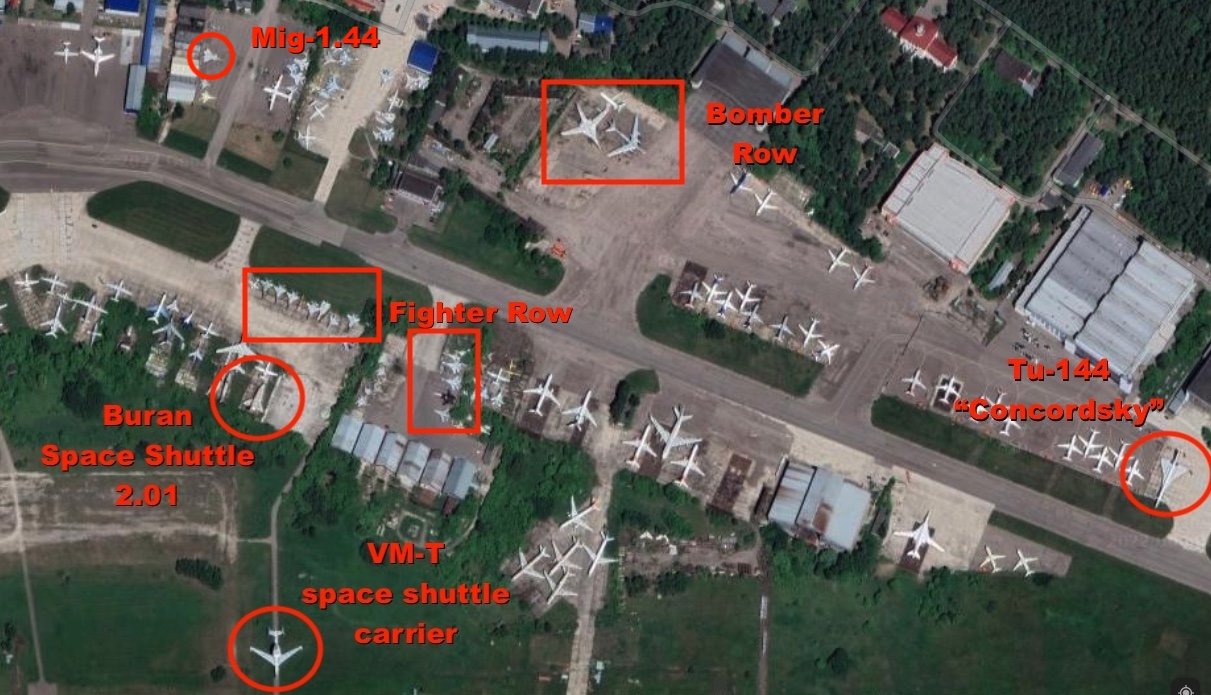
Strewn around its concrete parking aprons are a who’s who of historic — though often unsuccessful — Soviet and Russian aviation relics.
There is a Buran-class space shuttle, the direct Soviet rip-off of the US space shuttle. Though the shuttle never reached space, it’s now visible from there. The example at LII is one of three such Russian shuttles and supposedly one of just two still intact. The one at LII was, according to several online sources, the last one built as the program — and the Soviet Union — wound down. It was never named, probably never finished, and dubbed only “2.01.”
On the next apron to the left from 2.01 are what appear to be the hulks of two massive Mi-26 Halo helicopters. You can see that the helicopters are actually longer than the space shuttle — no surprise, since the Halo was the largest mass-produced helicopter in history. Though the blades are gone on both, you can see the massive rotor head where all eight blades were mounted. The Halo’s fuselage is twice as big as that of the US Army’s largest helicopter, the CH-47 Chinook, and could carry between 70 and 90 troops, depending on equipment and configuration — more than a US C-130.
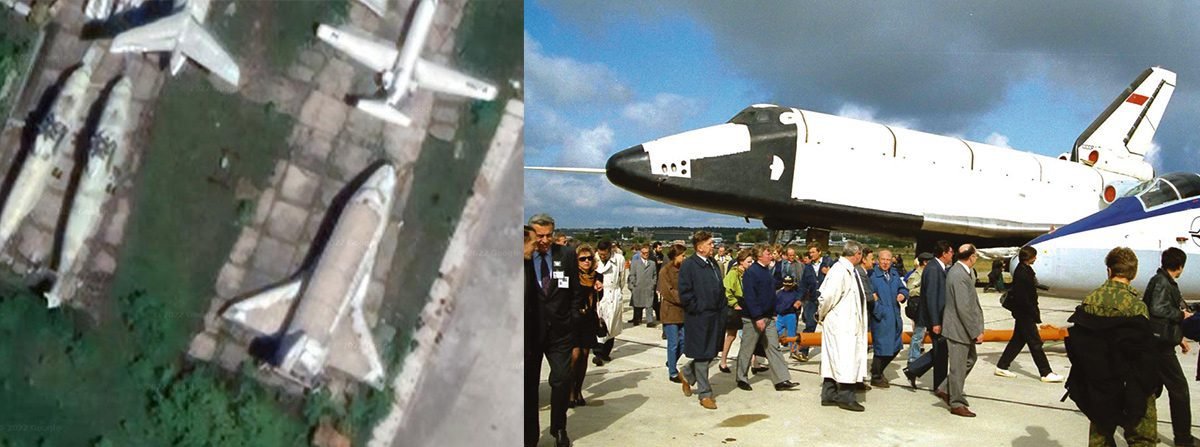
Just south of the shuttle, out on a wide-open stretch of grass near the airport’s main runways, is a giant VM-T Atlant transporter aircraft, a converted bomber that was created to carry the Buran on its back. The one sitting at LII has a giant, teardrop-shaped cargo pod where the shuttle would be. The VM-T is a converted 1950s-era Russian M-4 bomber, roughly on par with the B-47 Stratojet. After catching a ride on the VM-T during development, the Buran shuttles switched to flying on top of the legendary An-225, the largest cargo plane in the world until Russian troops destroyed it at the Hostomel airport in Ukraine during the initial days of the invasion.

While the VM-T sits just off of Zhukovsky‘s main runways almost as if on display for passing travelers, a far more famous plane might also be visible to travelers, though less conspicuously, a few hundred yards away. Sitting outside a nearby hangar is a Tu-144, the so-called Concordski or Concordsky, a Mach 2 airliner based on the British-French Concorde, which flew briefly in the 1970s and ’80s.
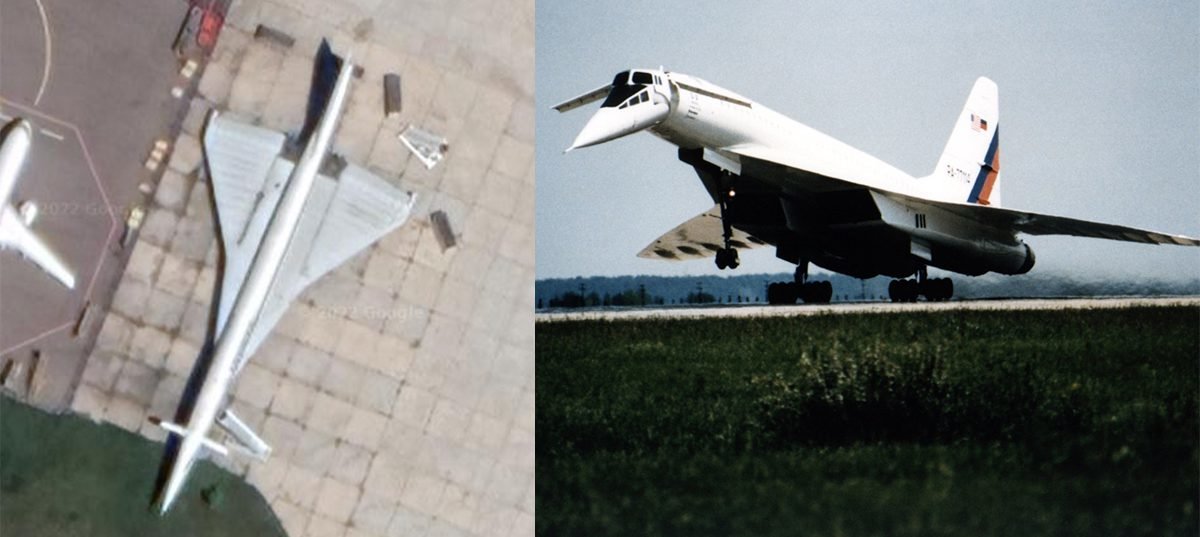
Most of what you need to know about the safety record and general flying experience of the Tu-144 lies in this fact: The early models are believed to be the only commercial passenger jets ever built with ejection seats — for the pilots, not the passengers.
In fact, the crazy facts about the supersonic airliner seem endless: It flew at over Mach 2 (about 1,400 mph) and could carry 140 passengers — 20 more than the Concorde — although it never did, as authorities worried so much about safety and maintenance that they limited the number allowed on board; it landed at roaring 200 mph (a 747 lands at about 160, a C-17 at about 125), limiting its usage to a small number of airports with miles-long runways; because its jets were in afterburner for most of the flight, noise inside the cabin was 90 to 95 decibels, which is roughly like being 50 feet from a jackhammer and the level generally accepted at which permanent hearing loss can begin (the noise was even worse in the rear of the plane); although 16 Tu-144s were produced, the entire fleet collectively flew fewer than 3,000 hours before being retired; one was briefly brought out of retirement as a flying test bed for NASA.
Like the Western Concorde, the Tu-144 was more famous for its delta wings and a series of crashes than for being a breakthrough in passenger aviation. One of the jets disintegrated in midair during the 1973 Paris Air Show, and another crashed in 1978. Still, they were a sight to behold. Though the one on the LII ramp appears to be cleaner and more intact than many of the planes around it, a gleaming, fully restored Tu-144 is less than a mile away on static display at the airport’s entrance. Its installation in 2019 was even captured on YouTube.
Not far from the Tu-144 is a “fighter row” with what looks to be at least one example of nearly every Russian fighter jet ever fielded. The row features nearly every known MiG, from the 1950s-era MiG-21 to the hyperfast MiG-25 and MiG-31, two of the fastest jets ever produced. The brawny interceptors were not meant to dogfight but rather to chase down the fastest Western Cold War bombers like the B-58 and B-1, the British Vulcan and cancelled TSR-2, and even — in theory — the wraithlike SR-71. Sadly, none of the interceptors at LII look ready to hunt, with most missing wings, noses, tails, or other parts.

But perhaps the most eclectic section is a line of six jets parked against a tree line, all in various stages of obvious disrepair. The line includes a Yak-28, the Russian navy’s version of a Harrier jet, capable of vertical takeoff. It’s surrounded by several versions of the Su-27, one of the most modern fighters in the world, flown by both Russia and Ukraine in their current war. Using the basic Su-27 airframe, Russian designers made slight changes over the years, adding canard wings to create the Su-33, expanding the cockpit to seat two pilots side by side in the Su-34, and upgrading the engines and avionics in an essentially identical airframe to create the Su-35. But while it’s fun to spot the different Su-27 derivatives together, they surround the real gem of the fleet: the black-painted, experimental, forward-swept-wing Su-47. Only one was ever built, and it’s sitting on the LII ramp.
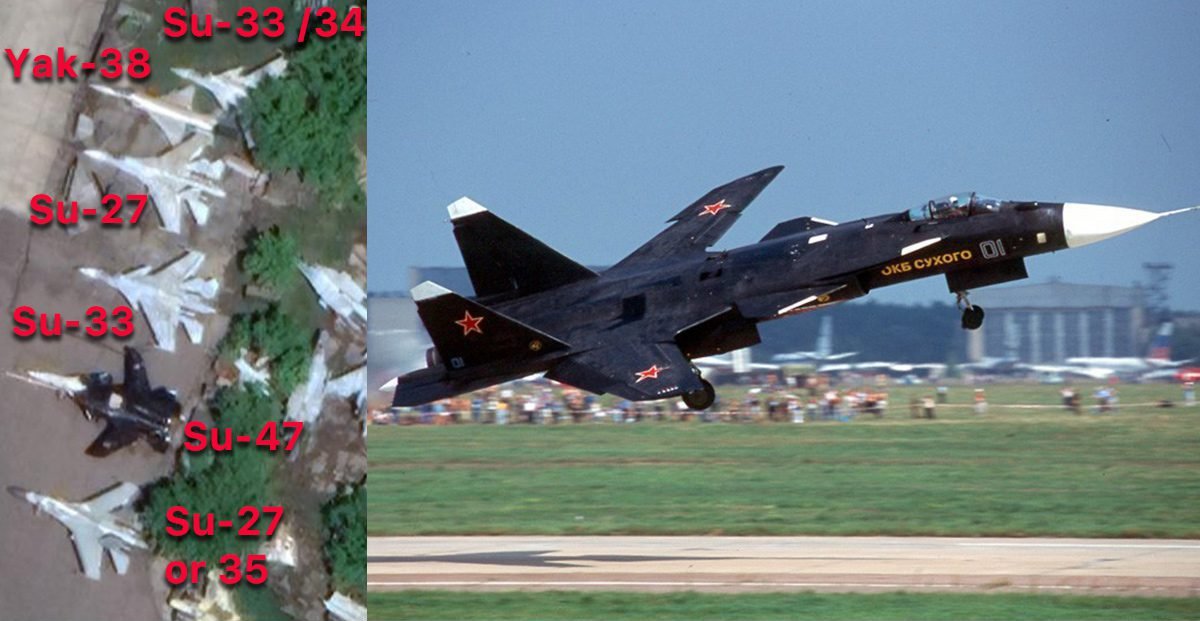
Just across the taxiway from the main fighter row, up against a series of nondescript hangars, is another one-of-a-kind gem: the single known prototype of Russia’s first attempt to take on the F-22, the MiG 1.44. The delta-winged fighter flew only twice, according to most sources.
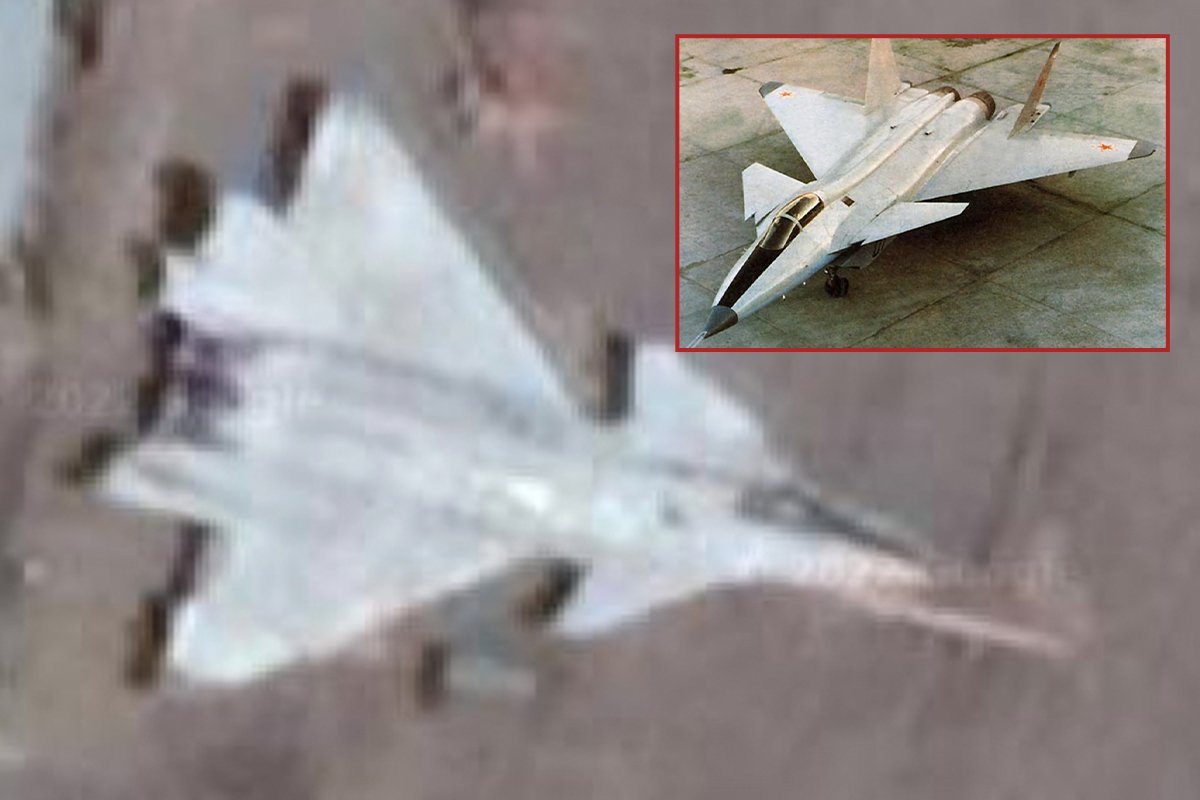
Perhaps a quarter of a mile down the taxiway from fighter row sits a sort of “bomber row,” with hulking, if obviously broken, Tu-160 Blackjack and Tu-95 Bear bombers. The Blackjack, with its wide-swept wings, was designed as the answer to the US B-1, while the prop-driven Bear — which dates to the early 1950s — was the Soviet answer to the venerable B-52. NORAD-directed fighters still intercept Bears around Alaska.
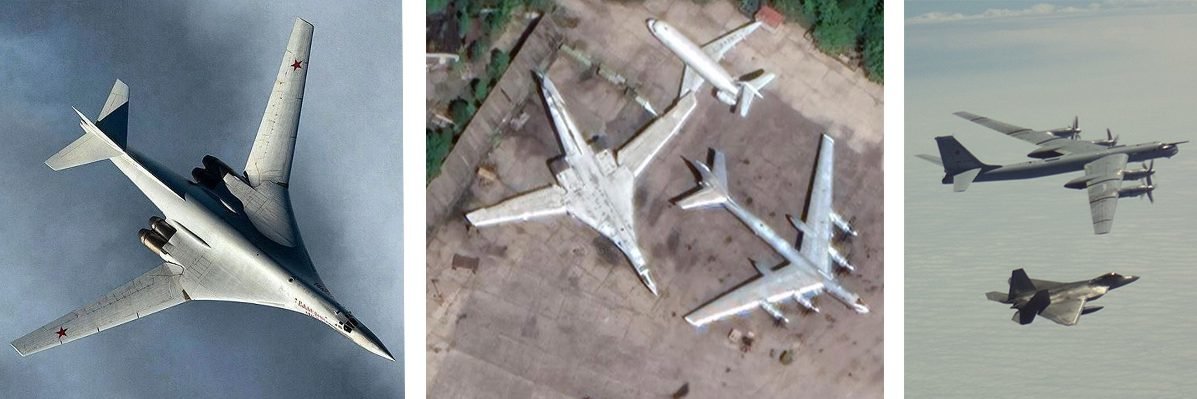
Coffee or Die Magazine attempted to make all of the aircraft identifications above using open source materials, including the Army Training Circular No. 3-01.80 Visual Aircraft Recognition. Did we miss one? Did you find some other great stuff? Let us know in the comments on our Facebook page.
Read Next:

Matt White is a former senior editor for Coffee or Die Magazine. He was a pararescueman in the Air Force and the Alaska Air National Guard for eight years and has more than a decade of experience in daily and magazine journalism.
BRCC and Bad Moon Print Press team up for an exclusive, limited-edition T-shirt design!
BRCC partners with Team Room Design for an exclusive T-shirt release!
Thirty Seconds Out has partnered with BRCC for an exclusive shirt design invoking the God of Winter.
Lucas O'Hara of Grizzly Forge has teamed up with BRCC for a badass, exclusive Shirt Club T-shirt design featuring his most popular knife and tiomahawk.
Coffee or Die sits down with one of the graphic designers behind Black Rifle Coffee's signature look and vibe.
Biden will award the Medal of Honor to a Vietnam War Army helicopter pilot who risked his life to save a reconnaissance team from almost certain death.
Ever wonder how much Jack Mandaville would f*ck sh*t up if he went back in time? The American Revolution didn't even see him coming.
A nearly 200-year-old West Point time capsule that at first appeared to yield little more than dust contains hidden treasure, the US Military Academy said.












